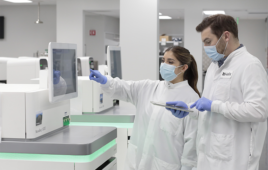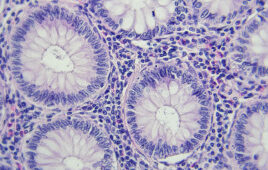
Blood plasma samples from a mouse that received the Angptl3 CRISPR treatment (right) and a mouse that was untreated (left). The cloudiness of the sample on the left is from the high content of cholesterol and triglycerides. Credit: Peggy Peterson Photography
Using a variation of CRISPR gene editing may be a potential strategy for mimicking the protective effects of a genetic mutation linked to lower cholesterol levels and heart disease risks, according to new mouse research from the Perelman School of Medicine at the University of Pennsylvania published this week in Circulation.
People with naturally occurring mutations that cause a loss of function in the gene for ANGPTL3 have reduced blood triglycerides, LDL cholesterol, and risk of coronary heart disease, with no apparent detrimental consequences to their health. This makes the ANGPTL3 protein an attractive target for new heart disease drugs. Earlier studies at Penn found that single copies of inactivating mutations in ANGPTL3 are found in about one in every 250 people of European heritage; however, people with mutations in both copies of the gene are more rare.
A team led by Kiran Musunuru, MD, PhD, MPH, an associate professor of Cardiovascular Medicine, assessed in a mouse model whether base editing – a variation of CRISPR genome editing that does not require breaks in the double-strand of DNA – might be used in humans one day to introduce mutations into ANGPTL3 to reduce blood lipid levels.
“This proof-of-principle study showed that base-editing of ANGPTL3 is a potential way to permanently treat patients with harmful blood lipid levels,” Musunuru said. “It would be especially useful in patients with a rare condition called homozygous familial hypercholesterolemia, which causes sky-high cholesterol levels and dramatically increased risk of heart attack. They are very difficult to treat with today’s medications, and a one-time CRISPR ‘vaccination’ might be ready to use in these patients within five years.”
The study took a three-part approach. First, the team injected normal mice with the base-editing treatment for the Angptl3 gene. After a week, sequencing of the Angptl3 target site in liver samples from the mice revealed a median 35 percent editing rate in the target gene and no off-target mutations. In addition, the mean levels of blood lipids were significantly lower in the treated mice by up to 30 percent compared to untreated mice.
Second, the researchers compared mice with the modified Angptl3 gene to those injected with a base-editing treatment for another liver gene, Pcsk9, for plasma cholesterol and triglycerides. After a week, Angptl3 targeting caused a similar reduction in cholesterol but a much greater decline in triglycerides compared to targeting Pcsk9. The PCSK9 protein is the target of currently available medications, including evinacumab, which has been shown to reduce cholesterol (but not triglycerides) as well as the risk of heart attack and stroke.
Third, they looked at how base editing of the Angptl3 gene performed in a mouse model of homozygous familial hypercholesterolemia (in which knocking out Pcsk9 had little effect). After two weeks, the treated mice showed substantially reduced triglycerides (56 percent) and cholesterol (51 percent) compared to untreated mice.
Musunuru’s lab is now preparing to test CRISPR-based treatments against the human ANGPTL3 gene in human liver cells transplanted into mice. This will provide important information on efficacy and safety that will be needed before human trials can move forward.
This work was supported by the National Institutes of Health (T32-HL007843, T32-GM007170, R01-HL118744, R01-HL126875).
The other Penn coauthors are Alexandra Chadwick, Niklaus Evitt, and Wenjian Lu.
Filed Under: Genomics/Proteomics




